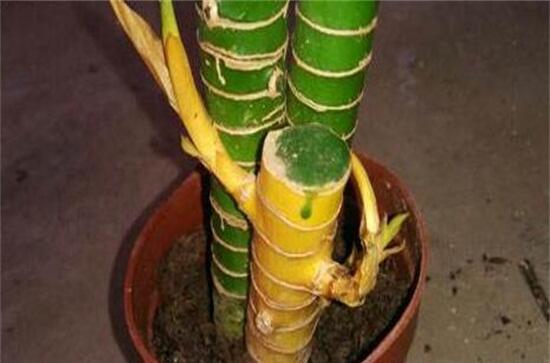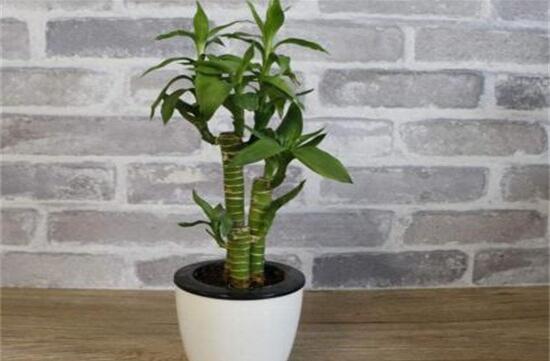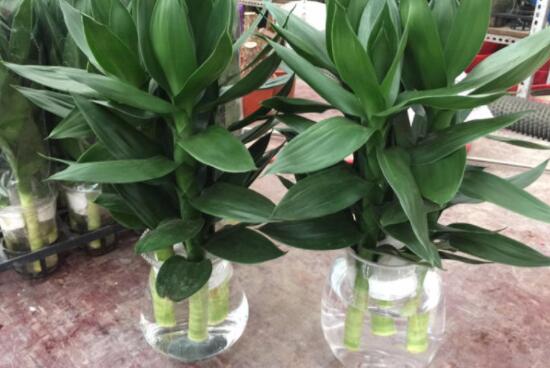What about the yellowing of lotus bamboo pillars, strong light shading / lack of water / spraying of diseases and insect pests
As a kind of green plant, lotus bamboo has many functions, but its ornamental value is the most popular. Lotus bamboo has a strong and straight plant type, green and lovely leaves, so when lotus bamboo leaves turn yellow and lotus bamboo pillars turn yellow, flower friends must be in a hurry! So, what about the yellowing of lotus bamboo pillars? Today, the editor is here to solve this problem for everyone.
First, what if the lotus bamboo pillars turn yellow

The yellowing of lotus bamboo pillars is generally caused by improper maintenance: if poor soil permeability leads to rotten roots, cut roots and change pots for soil replanting; if the light is too strong, shade in time; if there is insufficient water, you need to replenish water; if you encounter diseases and insect pests, you need to spray in time for prevention and control; if it is improper fertilization, then supplementary fertilization or irrigation dilution.
Second, the causes and solutions of the yellowing of lotus bamboo pillars.
1. Soil discomfort
Lotus bamboo does not have high requirements for soil, but not high does not mean that you can use soil casually. Once the soil permeability is too poor, normal watering will easily lead to stagnant water in the basin, and a long time will lead to rotting roots. If the lotus bamboo root is rotten, there will be a variety of symptoms, such as the lotus bamboo pillar yellowing.
Solution: at this time, we only need to change the basin soil, replace the loose, fertile, permeable and draining sandy soil; if there are rotten roots, we need to cut off the roots and plant them again.
2. The light is too strong
Lotus bamboo prefers semi-overcast environment, sufficient astigmatism can make it grow rapidly, but it is afraid of strong light, once it is exposed to too much light, or placed in strong light for a long time, it will directly lead to the yellowing of lotus bamboo pillars.
Solution: move the potted plant to a ventilated and shady place, water it appropriately, and slowly increase the light after it slows down; but in daily maintenance, you should give the lotus bamboo pot shade in summer, and when the light is not strong, you can let it bask in the sun.
3. Insufficient watering
Lotus bamboo likes a humid environment and should be watered frequently every day. If it is not watered enough, it will inhibit the growth of the plant, resulting in the phenomenon of bamboo rod yellowing and death.
Solution: what about the yellowing of lotus bamboo pillars? If it is caused by underwatering, it is very simple, good moisture can be, it is best to keep the basin soil moist; in addition, when the air is too dry, it should be sprayed every day.
4. Improper fertilization
When it is found that the lotus bamboo pillars turn yellow, we should consider whether there is something wrong with fertilization. Because when fertilizing too little, the bamboo pole will be lack of nourishment and yellowing; when fertilizing too much, it will burn the root, inhibit the absorption of the plant, and cause the bamboo pole to turn yellow.
Solution: when there is insufficient fertilization, appropriate amount of fertilizer can be applied; when excessive fertilization is applied, irrigation is needed to dilute the roots. if the roots have been burnt out, they need to be removed from the pot and cut off, and then replanted in the pot.
5. Diseases and insect pests
When it comes to the yellowing of lotus bamboo pillars, diseases and insect pests are a point that cannot be ignored. Because when the lotus bamboo suffers from leaf spot or root rot, its bamboo pole will appear yellow and brown spots, and then slowly spread, causing plant death in serious cases.
Solution: cut off the key parts, and then aim at spraying, as for what medicine to spray, different diseases and drugs are different, you can refer to lotus bamboo pest control.
What is the reason for the yellowing of lotus bamboo leaves? what about the yellowing of lotus bamboo leaves
Lotus bamboo, a beautiful ornamental plant with round stems like bamboo and leaves like lotus flowers, is often potted at home for family greening and decoration. However, in the process of breeding, many flower friends of the lotus bamboo will appear yellow leaves, affecting the ornamental, then what is the reason why the lotus bamboo leaves turn yellow? What if the lotus bamboo leaves turn yellow? In this regard, it is up to the editor to solve everyone's doubts.
What is the reason for the yellowing of lotus bamboo leaves
When it comes to the yellowing of lotus bamboo leaves, in addition to environmental discomfort, it is generally caused by improper maintenance: if the light is too strong, the leaves will burn and turn yellow; if the light is insufficient, the leaves will turn yellow if they cannot form chlorophyll; if there is insufficient fertilization, the leaves will be yellowed; if there is too much fertilization, it will lead to fertilizer damage, poor breathing of the roots, and yellowing of the leaves.
Second, what if the lotus bamboo leaves turn yellow?
1. Environmental mutation
With regard to the reasons for the yellowing of lotus bamboo leaves, if it is a new potted plant, we should consider environmental issues. Because nowadays, everyone's lotus bamboo potted plants are basically purchased online, which can easily lead to regional cross-service, environmental changes are too great, lotus bamboo can not adapt for a while and leaves are yellow.
Solution: it is very simple to replace the lotus bamboo with its favorite soil to ensure timely nutrition supply, and then according to the lotus bamboo culture method to create the most favorable growth environment, after a period of time, the plant will return to health.
2. The light is too strong
Although lotus bamboo needs light, it is more suitable for growing in places with sufficient astigmatism, and it is afraid of strong light. Once exposed to the strong sun in summer, it is easy to cause withering of the leaf tip and leaf edge, and yellow spots appear in the sunrise part of the leaf.
Solution: what if the lotus bamboo leaves turn yellow? If it is caused by too much light, we should move the pot to a shady place in time, water it appropriately, let it slow down and then slowly receive the light.
3. Lack of light
Although the lotus bamboo likes a shady environment, it also needs light. Once in the shady environment for a long time, the leaves of lotus bamboo can not get enough light, it can not form chlorophyll, the result is that the leaves of the whole lotus bamboo turn yellow, and then fall off, affecting the ornamental.
Solution: Lotus bamboo likes a cool environment, but it can't always be out of sight of the sun. We should let the lotus bamboo receive enough light while avoiding direct sunlight and strong light.
4. Insufficient fertilization
Although lotus bamboo does not require much fertilizer, proper fertilization can make it grow better. Once the fertilizer is insufficient, the leaves will turn yellow because they cannot absorb enough nutrients.
Solution: what if the lotus bamboo leaves turn yellow? If it is caused by insufficient fertilization, it is very simple, give it a timely application of nitrogen fertilizer, remember to apply thin fertilizer frequently, and add some alum.
5. Excessive fertilization
When fertilizing lotus bamboo, it must not be too much, because too much or too thick fertilizer may burn out the roots and cause the old leaves to turn yellow and fall off. Although the new leaves will not turn yellow, they will also become dull and unstretched.
The solution: stop fertilizing immediately, then irrigate it with water, and let the fertilizer be diluted and flow out from the bottom of the basin; if the root system has been burnt out, people need to take off the pot and cut the root, and then change the pot soil to plant again.
Generally speaking, lotus bamboo is not difficult to raise, but because many flower friends are novice, it is inevitable to have the symptom of leaf yellow. However, after reading the full text, I believe you have a bottom in your mind, and the Ye Huang problem can be remedied in accordance with the above methods. With regard to the yellowing of lotus bamboo leaves, the editor has introduced this, hoping to give you some help.
How to deal with lotus bamboo worms, lotus bamboo diseases and insect pests control / leaf spot disease spraying
In indoor plant cultivation, diseases and insect pests need to be paid attention to, because their appearance will often bring a devastating blow to the plant. As a beautiful green plant, lotus bamboo is not only good-looking, but also effective, so it is often potted at home. So, in the process of breeding, lotus bamboo worms how to do? The following are several kinds of lotus bamboo pest control, let's go and have a look!
1. How to deal with the lotus bamboo worm
Lotus bamboo is tenacious and rarely infects insects, but in the case of improper maintenance and poor environment, it will also grow insects and get sick. Among them, the main diseases of lotus bamboo are leaf spot, root rot and anthracnose, and the main pests are shell insects and red spiders, which will affect the health and beauty of the plant, so they should be eliminated as soon as they are found.
II. Disease and pest control of lotus bamboo
1. The shell worm of lotus bamboo
Although lotus bamboo is not easy to infect insects, in an environment of poor ventilation and poor light, shell insects will also come to the door. The insect generally floats and attaches to the leaf surface of the plant, and the secretion pollutes the leaves, affecting the photosynthesis of the plant, resulting in wilting of the leaves and inducing coal fouling disease.
Prevention and control methods: when there are few shell insects, you can gently brush off the insects with a brush dipped in water, and then spray white vinegar to prevent them; when there are too many shell insects, you can spray 1000 times of omethoate for prevention and control, once a week for 2 or 3 times in a row.
2. Lotus Bamboo Red Spider
In addition to shell insects, under the condition of high temperature, high humidity and poor ventilation, lotus bamboo may also give birth to red spiders. The insect mainly uses mouthparts to pierce into the leaves of lotus bamboo to suck juice, which destroys the chlorophyll of the plant and causes the leaves of lotus bamboo to turn yellow and even detach.
Control methods: when individual leaves are damaged, insect leaves can be removed; when more leaves are damaged, propargite, dimethoate, Huachongjing and other drugs should be sprayed as soon as possible.
3. Lotus bamboo root rot
In the case of improper maintenance, lotus bamboo will also get sick, of which the most common is root rot. The disease generally occurs in excessive watering or poor drainage of basin soil, coupled with the occurrence of dark indoor conditions, resulting in black rot of roots and stems of lotus bamboo, as well as yellowing of lotus bamboo pillars.
Prevention and treatment: after the above diseases are found, the rotten parts of lotus bamboo are cut off, applied with sulfur powder, and then replaced with fresh culture soil and replanted.
4. Leaf spot of lotus bamboo
When indoor temperature fluctuates greatly in a short period of time, or too much watering during dormancy, lotus bamboo is also prone to leaf spot disease. The disease mainly causes harm to the lower leaves of the lotus bamboo, the diseased leaves will appear many small brown spots, in serious cases will spread throughout the leaves.
Prevention and treatment methods: when the above diseases are found, remove the diseased leaves in time and destroy them centrally in order to reduce the source of the disease; at the initial stage of the disease, the foliar surface can be sprayed with 42% gram fungus powder 3000 times, once every 5-7 days, 2 times every 3 times, which can be basically cured.
5. Anthracnose of lotus bamboo
In the prevention and control of lotus bamboo diseases and insect pests, anthracnose is also something that everyone needs to prevent. The disease easily occurs when the humidity is too high and the environment is not ventilated in the rainy season. If the leaf tip of the lotus bamboo turns black and the leaves have yellow spots, it should be suffering from anthracnose.
Prevention and treatment methods: when the above diseases are found, if it is winter and spring, the diseased leaves should be removed and destroyed in time, and the soil should be disinfected with quicklime. At the initial stage of the disease, 75% chlorothalonil 600 times or 50% thiram wettable powder 500 times can be sprayed once every 7 to 10 days, 3 times in a row.
With regard to the prevention and control of lotus bamboo diseases and insect pests, the editor has introduced this. I believe that if you encounter lotus bamboo worms or get sick again, you should know how to do it! Generally speaking, the breeding method of lotus bamboo is not difficult, as long as we take good care of it, bugs will not come to us. Finally, may your lotus bamboo grow beautifully.
- Prev

How to raise lotus bamboo, culture methods and matters needing attention / like astigmatism exposure
For lotus bamboo, flower friends should be no stranger, it is thick and long, evergreen all the year round, stem straight and elegant, chic posture, is a beautiful ornamental plant. In life, after discovering lotus bamboo, many friends want to raise it, so how to raise lotus bamboo? The following are the culture methods and precautions of lotus bamboo, which are very detailed.
- Next

Lotus bamboo can be cultured in water? Lotus bamboo water culture method/avoid cold wind 15 natural roots
Lotus bamboo, just like its name, its stem like bamboo, leaves like lotus, looks very beautiful, deeply loved by flower friends. However, many flower lovers prefer water culture to soil culture. Can lotus bamboo be cultured in water? If possible, how does the lotus bamboo grow?
Related
- Fuxing push coffee new agricultural production and marketing class: lack of small-scale processing plants
- Jujube rice field leisure farm deep ploughing Yilan for five years to create a space for organic food and play
- Nongyu Farm-A trial of organic papaya for brave women with advanced technology
- Four points for attention in the prevention and control of diseases and insect pests of edible fungi
- How to add nutrient solution to Edible Fungi
- Is there any good way to control edible fungus mites?
- Open Inoculation Technology of Edible Fungi
- Is there any clever way to use fertilizer for edible fungus in winter?
- What agents are used to kill the pathogens of edible fungi in the mushroom shed?
- Rapid drying of Edible Fungi

